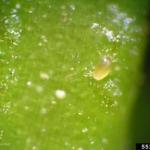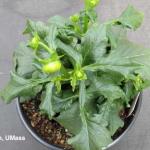Broad mites (Polyphagotarsonemus latus) have been encountered regularly in spring greenhouse crops over the last few years. The broad mite is a tropical species and does not survive the winter in temperate climates. In northern climates it occurs frequently in greenhouse environments as a result of being introduced with plant material. Broad mites have a wide range of host plants including many ornamental crops such as New Guinea impatiens, begonia, gerbera, snapdragon and vegetable crops such as peppers, tomato and cucumber.
The life cycle of broad mites consists of egg, larva and adult. High relative humidity (70-90%) and high temperatures (67-77º F) favor development. Female adults lay eggs mainly on the underside of young leaves. Eggs are shaped like an elongated oval about 0.07mm long, and are almost transparent with specked white dots or bumps. The larva resembles the adult, but is slightly smaller. Adults are about 0.2mm long, oval and broad, and pale yellow or yellowish green. Females have a white stripe on their backs. Males are smaller (0.15mm) with a body that tapers towards the rear end, and have no white stripe on the back.
Broad mites are very small (0.1-0.3mm long) and therefore can be very difficult to observe. High magnification (20 – 30X) and good lighting are important monitoring tools. It is easier to detect eggs than the larvae or adults. Larvae and adults are harder to find because they tend to hide within tender buds and new growth. The presence of eggs confirms that broad mites are present. Mite activity is more likely to be detected on foliage near the growing points of a plant.
The typical pattern of broad mite damage consists of malformation and distortion of the growing point, young leaves and flower buds. Leaves become stunted, twisted, hardened, and distorted with bronzed lower surfaces. Flowers have fine flecking on petals and sometimes flowers are either very stunted, malformed, or fail to open at all. Broad mite damage can be confused with virus symptoms, herbicide injury, temperature injury or deficiency of calcium or boron. Laboratory diagnosis is sometimes necessary to verify broad mite damage.
Broad mite infestation is often localized, although mites can spread in the greenhouse by attaching themselves to the legs of whiteflies and aphids or dispersal by workers moving through the crop. Regularly inspect crops for symptoms. Remove infested plants and use good sanitation practices such as removing weeds and keeping the greenhouse clean. Avoid working in areas with infested crops prior to moving to healthy crops. Control whiteflies and aphids.
Biological management: Neoseiulus cucumeris and Amblyseius swirskii predatory mites can control broad mites if released before populations are high. Amblyseius californicus predatory mites can also be used to control broad mites if released early in the crop cycle.
Management with miticides: Apply foliar sprays of translaminar miticides such as Avid, Sirocco and Savate (do not use Savate on New Guinea impatiens or geranium). Make sure to rotate across different modes of action (MOAs) to prevent resistance development in the pest population. Note that not all miticides labeled for spider mites are labeled for broad mites. As always, read pesticide labels for plant safety information and make sure to follow all label recommendations and restrictions.
For more information on broad mites refer to the following links:
- Broad Mites and Cyclamen Mites on Greenhouse Crops: http://ipm.uconn.edu/documents/raw2/1103/2019broadmitescyclamenmitesfsfinal2.pdf
- Broad Mites on Ornamental Peppers: http://e-gro.org/pdf/2016_538.pdf
- Broad Mites on New Guinea Impatiens: http://e-gro.org/pdf/E-GRO_Bulletin_1_16.pdf
Geoffrey Njue, Extension Educator, UMass Extension's Greenhouse Crops & Floriculture Program



